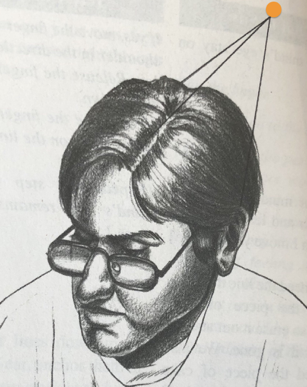Speed Reading Technique 10 – Take your awareness to your concentration point
SUMMARY: Focus on a point about 15 cms above and slightly behind the top of your head (your concentration point) – take a deep breath in and relax your eyes as you breathe out. Then start reading.
Many people can increase their reading speed simply by taking their attention to the concentration point about 15 cms above and slightly behind the top of the head. Many notice a different quality to their reading, saying the text is ‘clearer’ and ‘easier to understand’. Their ability to concentrate is also enhanced.
TEST YOURSELF …
… before and after doing this technique to see the difference it makes to you – see QUICK TEST
HOW TO do it

Concentration point for speed reading from The Gift of Dyslexia
Close your eyes. Take your attention to (ie simply become aware of) a point about 15 cms above and slightly behind the top of your head. Even with your eyes closed, feel your eyes softening as your peripheral vision opens. Pause and plan what you are going to do once you start your reading session. Take a deep breath in, smile and open your eyes as you exhale. Start reading.
You do not need to keep concentrating on the point as you read. If you find your concentration wandering after a time, take a short break to move and breathe and then re-focus on the concentration point before you start reading again.
Additional help
The more you take your concentration to this point, the easier it gets, but if initially, you need some help, try whichever of the following works best for you. (You might like to try them all before deciding.)
- Touch the top of your head and move your hand back and up to the concentration point. Move your attention to the point, and keep it there when you remove your hand.
- Imagine placing an orange on that point (initially it can be easier to focus on something concrete rather than space)
- Instead of an orange, try a melon …
- … or a balloon.
- Relax and focus on your left foot; then take your attention to your right knee; then to your left hip, right palm, left elbow, right shoulder – and then to the concentration point above and behind your head.
Opening your peripheral vision
Focusing on the concentration point automatically opens your peripheral vision (speed reading technique number 9).
Do it before you start driving (you’re much more aware of other road users), when you’re walking at night (it’s easier to avoid trouble), just before you start an exam paper (you get into a good state for remembering information) – or whenever you feel you would benefit from greater powers of (effortless) concentration.
How do we know about this point of concentration?
First think about this question: What do the following have in common?
- dunce • wizard • saint • yogi
Answer? All (originally) knew the importance of focusing on a point above and behind the crown of the head in order to enhance their ability to concentrate and be fully aware.
This point has been well known for many years. It is depicted as a halo in many pictures of Christian saints, yogis know it as the 8th chakra (which gives access to universal wisdom), and witches and wizards wore a hat which reminded them to focus on this point in order to enhance their magic powers.
In the 13th century, a Franciscan monk and philosopher, John Duns Scotus, developed a ‘duns cap’ to be worn by children who needed something to help them focus. Detractors of Scotus made fun of the cap. Over time the ‘dunce’s cap’ came to be associated with ‘stupid’ children, and was eventually misunderstood and used to stigmatise and make fun of such children. More about ‘dunce’s cap’
More recently, when Ron Davis was working with children diagnosed as dyslexic, he discovered that asking the children to concentrate on this point was enough to allow many of them to start reading (see his book ‘The Gift of Dyslexia’). Ron Davis calls this point of awareness or concentration “visuo-awareness epicenter.” When Paul Scheele was developing his PhotoReading system, he thought that concentrating on this point might also help everyone read better and calls it the “tangerine technique” where you imagine a real tangerine as a point of reference up and behind your head. And it does make a difference for most people.

